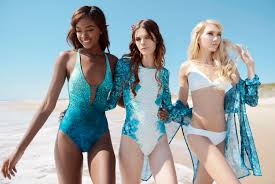
The swimwear industry has long been dominated by classic styles and mainstream designs, yet the rise of Alternative Swimwear has challenged conventional norms. Today, beachgoers and pool enthusiasts seek clothing that not only fits comfortably but also expresses individuality, creativity, and personal style. Alternative swimwear offers bold, unique, and unconventional designs that allow wearers to stand out while embracing their identity and aesthetic preferences. From edgy patterns and cutouts to sustainable fabrics and gender-fluid designs, this segment of swimwear is redefining how we approach beach fashion.
Defining Alternative Swimwear
Alternative swimwear is characterized by its departure from traditional bikinis, one-piece suits, and swim trunks. It embraces originality, experimental silhouettes, vibrant colors, and unique textures. This category includes a wide range of styles, such as high-fashion swimwear, cyberpunk-inspired designs, gothic and punk aesthetics, retro-futuristic cuts, and even DIY or custom-made pieces. The central idea is to move beyond mainstream expectations, allowing the wearer to make a statement while enjoying functional beachwear.
Unlike conventional swimwear, which often prioritizes broad market appeal, alternative swimwear emphasizes individuality and self-expression. It caters to diverse body types, subcultures, and lifestyle preferences. For example, some designs feature bold straps, metallic embellishments, mesh panels, or cutouts that create visually striking silhouettes. Others integrate unusual textures, like latex, neoprene, or crochet, which further enhance the uniqueness of the garment.
Materials and Sustainability
One significant trend within alternative swimwear is the use of sustainable and innovative materials. Many designers prioritize eco-friendly fabrics such as recycled nylon, organic cotton blends, and regenerated polyester made from discarded plastics. These materials not only reduce environmental impact but also offer durability, comfort, and unique textures that differentiate alternative designs from standard options.
Neoprene, commonly used in wetsuits, has gained popularity in alternative swimwear for its structured form and futuristic appeal. Similarly, latex and PVC-inspired fabrics create bold, statement-making looks, often paired with intricate detailing or accessories. For those seeking a softer touch, handmade crochet or knitted swimwear pieces offer a retro yet unconventional aesthetic, showcasing craftsmanship and creativity. Sustainability in alternative swimwear is about combining eco-conscious choices with high-fashion elements, proving that unique designs can also be responsible.
Bold Colors and Patterns
Color is a defining element in alternative swimwear. Bright neons, deep jewel tones, and iridescent finishes capture attention and create a visually arresting presence on the beach. Many pieces incorporate color-blocking, geometric patterns, and asymmetrical designs to challenge traditional expectations of swimwear aesthetics. Tie-dye patterns, holographic finishes, and animal prints also feature prominently, appealing to those who want to make a bold statement.
Patterned swimwear goes beyond simple prints, often merging different textures and motifs into a cohesive design. For example, a swimsuit may combine mesh panels with metallic studs or layered cutouts with vivid tie-dye patterns. This approach ensures that each piece is eye-catching and distinctive, providing wearers with a confident and stylish look that stands out from conventional swimwear.
Innovative Silhouettes and Cuts
Alternative swimwear frequently experiments with unconventional silhouettes. Strappy designs, asymmetrical cuts, high-waisted bottoms with unusual paneling, and one-shoulder tops offer fresh alternatives to traditional bikinis and one-pieces. Some designs feature exaggerated high-leg cuts, corset-inspired lacing, or removable panels, giving wearers flexibility and customization options.
These innovative silhouettes allow individuals to showcase their personal style while accommodating different body shapes. For instance, high-waisted bottoms paired with structured tops can create flattering proportions, while cutout designs or intricate strap arrangements draw attention to specific areas of the body in a creative and confident way. Alternative swimwear challenges the notion that functionality must come at the expense of aesthetic boldness, proving that comfort and style can coexist in extraordinary designs.
Gender-Fluid and Inclusive Designs
A major trend within alternative swimwear is the move toward gender-fluid and inclusive designs. Designers are increasingly creating pieces that transcend traditional gender norms, offering versatile options for everyone. This includes unisex swimwear, oversized pieces that defy conventional sizing, and designs that cater to various body types without sacrificing style.
Inclusive swimwear emphasizes body positivity and self-expression, encouraging individuals to embrace their unique features. By prioritizing fit, adaptability, and aesthetic appeal, alternative swimwear allows people of all identities and shapes to feel confident and stylish while enjoying beach or poolside activities.
Accessories and Styling Options
Alternative swimwear is often complemented by bold accessories that enhance the overall look. Oversized sunglasses, statement hats, layered jewelry, and colorful sarongs can elevate an outfit while maintaining the unconventional aesthetic. Footwear such as platform sandals, gladiator-style flats, or metallic slides also pairs well with daring swimwear designs, completing the ensemble.
Some designs include built-in accessories, such as chains, studs, or detachable straps, which allow wearers to modify their look depending on the setting. These additional elements reinforce the idea that alternative swimwear is more than just functional attire—it is an opportunity for personal expression and fashion experimentation.
Customization and DIY Trends
Many enthusiasts of alternative swimwear embrace customization and DIY projects. Handmade modifications, tie-dye techniques, embroidery, or adding embellishments allow individuals to create one-of-a-kind pieces. Custom swimwear offers a unique sense of ownership and allows the wearer to express their personality more fully. Online communities and social media platforms often showcase DIY trends, inspiring new designs and collaborations.
Customization also reflects a broader movement in fashion toward individuality and sustainability. By modifying or repurposing existing pieces, wearers can reduce waste while expressing their personal style in creative ways.
Events and Communities Supporting Alternative Swimwear
Alternative swimwear has gained visibility through niche events, fashion shows, and social media communities. Festivals, pool parties, and photo shoots often highlight bold and unconventional designs, encouraging self-expression and confidence. Online communities provide platforms for sharing style tips, showcasing creative outfits, and discovering emerging designers. These spaces foster inclusivity and innovation, allowing wearers to connect with like-minded individuals who appreciate the artistry and creativity of alternative swimwear.
Conclusion
Alternative swimwear is transforming the way people approach beach and pool fashion. By offering unique designs, bold colors, innovative silhouettes, sustainable materials, and inclusive options, it empowers wearers to express their individuality and embrace self-confidence. From gender-fluid styles to DIY customizations, alternative swimwear celebrates creativity and personal expression while maintaining functionality and comfort. Whether attending a festival, lounging by the pool, or enjoying a day at the beach, alternative swimwear provides a distinctive way to stand out and make a statement. As trends continue to evolve, this segment of fashion will remain at the forefront of daring, stylish, and expressive beachwear, redefining what it means to wear swimwear boldly and unapologetically.



